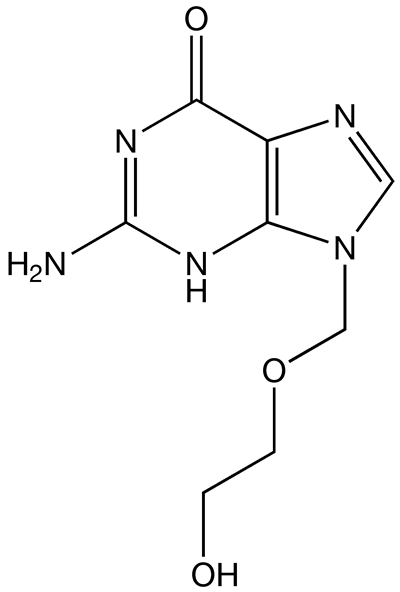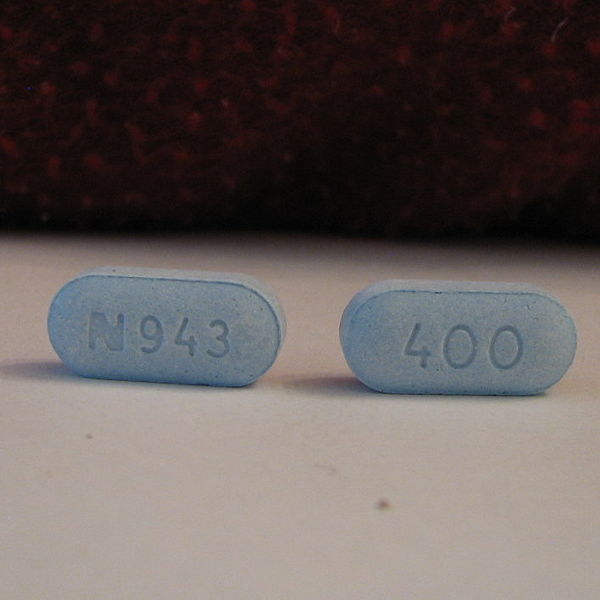Aciclovir
 | |
 | |
| Clinical data | |
|---|---|
| Synonyms | acycloguanosine |
| Pregnancy category | |
| Routes of administration | IV, oral, topical |
| ATC code | |
| Legal status | |
| Legal status |
|
| Pharmacokinetic data | |
| Bioavailability | 10–20% (oral) |
| Protein binding | 9-33% |
| Metabolism | Viral thymidine kinase |
| Elimination half-life | 2.2–20 hours |
| Excretion | Renal |
| Identifiers | |
| |
| CAS Number | |
| PubChem CID | |
| DrugBank | |
| E number | {{#property:P628}} |
| ECHA InfoCard | {{#property:P2566}}Lua error in Module:EditAtWikidata at line 36: attempt to index field 'wikibase' (a nil value). |
| Chemical and physical data | |
| Formula | C8H11N5O3 |
| Molar mass | 225.21 g/mol |
| Melting point | 256.5 °C (493.7 °F) |

|
WikiDoc Resources for Aciclovir |
|
Articles |
|---|
|
Most recent articles on Aciclovir |
|
Media |
|
Evidence Based Medicine |
|
Clinical Trials |
|
Ongoing Trials on Aciclovir at Clinical Trials.gov Clinical Trials on Aciclovir at Google
|
|
Guidelines / Policies / Govt |
|
US National Guidelines Clearinghouse on Aciclovir
|
|
Books |
|
News |
|
Commentary |
|
Definitions |
|
Patient Resources / Community |
|
Patient resources on Aciclovir Discussion groups on Aciclovir Directions to Hospitals Treating Aciclovir Risk calculators and risk factors for Aciclovir
|
|
Healthcare Provider Resources |
|
Causes & Risk Factors for Aciclovir |
|
Continuing Medical Education (CME) |
|
International |
|
|
|
Business |
|
Experimental / Informatics |
Overview
Aciclovir (INN) (IPA: Template:IPA) or acyclovir (USAN, former BAN), chemical name acycloguanosine, is a guanine analogue antiviral drug, marketed under trade names such as Zovirax and Zovir (GSK). One of the most commonly-used antiviral drugs, it is primarily used for the treatment of herpes simplex virus infections, as well as in the treatment of herpes zoster (shingles).
Aciclovir was seen as the start of a new era in antiviral therapy, as it is extremely selective and low in cytotoxicity. Pharmacologist Gertrude B. Elion was awarded the 1988 Nobel Prize in Medicine, partly for the development of aciclovir.
Pharmacology
Mechanism of action
Aciclovir differs from previous nucleoside analogues in that it contains only a partial nucleoside structure: the sugar ring is replaced by an open-chain structure. It is selectively converted into acyclo-guanosine monophosphate (acyclo-GMP) by viral thymidine kinase, which is far more effective (3000 times) in phosphorylation than cellular thymidine kinase. Subsequently, the monophosphate form is further phosphorylated into the active triphosphate form, acyclo-guanosine triphosphate (acyclo-GTP), by cellular kinases. Acyclo-GTP is a very potent inhibitor of viral DNA polymerase; it has approximately 100 times greater affinity for viral than cellular polymerase. As a substrate, acyclo-GMP is incorporated into viral DNA, resulting in chain termination. It has also been shown that viral enzymes cannot remove acyclo-GMP from the chain, which results in inhibition of further activity of DNA polymerase. Acyclo-GTP is fairly rapidly metabolised within the cell, possibly by cellular phosphatases.
In sum, aciclovir can be considered a prodrug: it is administered in an inactive (or less active form) and is metabolised into a more active species after administration.
Microbiology
Aciclovir is active against most species in the herpesvirus family. In descending order of activity:[1]
- Herpes simplex virus type I (HSV-1)
- Herpes simplex virus type II (HSV-2)
- Varicella zoster virus (VZV)
- Epstein-Barr virus (EBV)
- Cytomegalovirus (CMV)
Activity is predominantly against HSV, and to a lesser extent VZV. It is only of limited efficacy against EBV and CMV. It is inactive against latent viruses in nerve ganglia.
To date, resistance to aciclovir has not been clinically significant. Mechanisms of resistance in HSV include deficient viral thymidine kinase; and mutations to viral thymidine kinase and/or DNA polymerase, altering substrate sensitivity.[2]
Pharmacokinetics
Aciclovir is poorly water soluble and has poor oral bioavailability (10–20%), hence intravenous administration is necessary if high concentrations are required. When orally administered, peak plasma concentration occurs after 1–2 hours. Aciclovir has a high distribution rate, only 30% is protein-bound in plasma. The elimination half-life of aciclovir is approximately 3 hours. It is renally excreted, partly by glomerular filtration and partly by tubular secretion.
Clinical use
Indications
Aciclovir is indicated for the treatment of HSV and VZV infections, including:[3]
- Genital herpes simplex (treatment and prophylaxis)
- Herpes simplex labialis (cold sores)
- Herpes zoster (shingles)
- Acute chickenpox in immunocompromised patients
- Herpes simplex encephalitis
- Acute mucocutaneous HSV infections in immunocompromised patients
- Herpes simplex keratitis (ocular herpes)
- Herpes simplex blepharitis (not to be mistaken with ocular herpes)
- Bell's Palsy
It has been claimed that the evidence for the effectiveness of topically applied cream for recurrent labial outbreaks is weak.[4] Likewise oral therapy for episodes is inappropriate for most non-immunocompromised patients, whilst there is evidence for oral prophylactic role in preventing recurrences.[5]
Dosage forms
Aciclovir is commonly marketed as tablets (200 mg, 400 mg and 800 mg), topical cream (5%), intravenous injection (25 mg/mL) and ophthalmic ointment (3%). Cream preparations are used primarily for labial herpes simplex. The intravenous injection is used when high concentrations of aciclovir are required. The ophthalmic ointment preparation is only used for herpes simplex keratitis .
Adverse effects
Systemic therapy
Common adverse drug reactions (≥1% of patients) associated with systemic aciclovir therapy (oral or IV) include: nausea, vomiting, diarrhea and/or headache. In high doses, hallucinations have been reported. Infrequent adverse effects (0.1–1% of patients) include: agitation, vertigo, confusion, dizziness, oedema, arthralgia, sore throat, constipation, abdominal pain, rash and/or weakness. Rare adverse effects (<0.1% of patients) include: coma, seizures, neutropenia, leukopenia, crystalluria, anorexia, fatigue, hepatitis, Stevens-Johnson syndrome, toxic epidermal necrolysis and/or anaphylaxis.[3]
Additional common adverse effects, when aciclovir is administered IV, include encephalopathy (1% of patients) and injection site reactions. The injection formulation is alkaline (pH 11), and extravasation may cause local tissue pain and irritation.[3] Renal impairment has been reported when aciclovir is given in large, fast doses intravenously, due to the crystallisation of aciclovir in the kidneys.
Topical therapy
Aciclovir topical cream is commonly associated (≥1% of patients) with: dry or flaking skin and/or transient stinging/burning sensations. Infrequent adverse effects include erythema and/or itch.[3]
When applied to the eye, aciclovir is commonly associated (≥1% of patients) with transient mild stinging. Infrequently (0.1–1% of patients), ophthalmic aciclovir is associated with superficial punctate keratitis and/or allergic reactions.[3]
Toxicity
Since aciclovir can be incorporated also into the cellular DNA, it is a chromosome mutagen, therefore, its use should be avoided during pregnancy. However it has not been shown to cause any teratogenic nor carcinogenic effects. The acute toxicity (LD50) of aciclovir when given orally is greater than 1 g/kg, due to the low oral bioavailability. Single cases have been reported, where extremely high (up to 80 mg/kg) doses have been accidentally given intravenously without causing any major adverse effects.
Footnotes
- ↑ O'Brien JJ, Campoli-Richards DM. Acyclovir. An updated review of its antiviral activity, pharmacokinetic properties and therapeutic efficacy. Drugs 1989;37(3):233-309. PMID 2653790
- ↑ Sweetman S, editor. Martindale: The complete drug reference. 34th ed. London: Pharmaceutical Press; 2004. ISBN 0-85369-550-4
- ↑ 3.0 3.1 3.2 3.3 3.4 Rossi S, editor. Australian Medicines Handbook 2006. Adelaide: Australian Medicines Handbook; 2006. ISBN 0-9757919-2-3
- ↑ Graham Worrall (1996). "Evidence for efficacy of topical acyclovir in recurrent herpes labialis is weak". BMJ. 313: 46. Unknown parameter
|month=ignored (help)- Letter - ↑ Graham Worrall (1996). "Acyclovir in recurrent herpes labialis". BMJ. 312: 6. Unknown parameter
|month=ignored (help) - Editorial
Further reading
- Harvey Stewart C. in Remington’s Pharmaceutical Sciences 18th edition: (ed. Gennard, Alfonso R.) Mack Publishing Company, 1990. ISBN 0-912734-04-3.
- Huovinen P., Valtonen V. in Kliininen Farmakologia (ed. Neuvonen et al.). Kandidaattikustannus Oy, 1994. ISBN 951-8951-09-8.
- Périgaud C., Gosselin G., Imbach J. -L.: Nucleoside analogues as chemotherapeutic agents: a review. Nucleosides and nucleotides 1992; 11(2-4)
- Rang H.P., Dale M.M., Ritter J.M.: Pharmacology, 3rd edition. Pearson Professional Ltd, 1995. 2003 (5th) edition ISBN 0-443-07145-4; 2001 (4th) edition ISBN 0-443-06574-8; 1990 edition ISBN 0-443-03407-9.
- Pages with script errors
- Pages with citations using unsupported parameters
- Drugs with non-standard legal status
- E number from Wikidata
- ECHA InfoCard ID from Wikidata
- Chemical articles with unknown parameter in Infobox drug
- Articles without EBI source
- Chemical pages without ChemSpiderID
- Articles without KEGG source
- Articles without InChI source
- Articles without UNII source
- Articles containing unverified chemical infoboxes
- Purines
- Antivirals